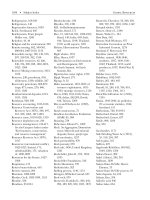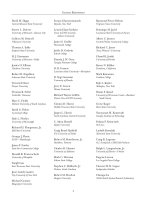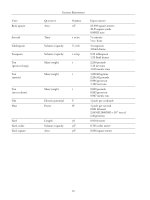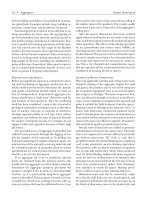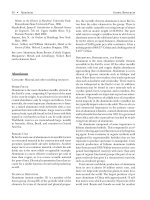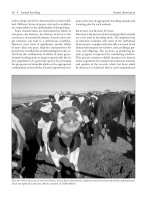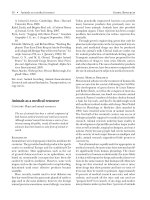Encyclopedia of Global Resources part 17 pptx
Bạn đang xem bản rút gọn của tài liệu. Xem và tải ngay bản đầy đủ của tài liệu tại đây (342.57 KB, 10 trang )
the group. There is only one naturally occurring iso
-
tope, so the atomic weight of bismuth, 208.980, is
known very precisely. The element is brittle and white
in appearance, with a pink tinge. It occurs in a variety
of crystalline structures. The metal has a high resistiv-
ity and melts at 271.4° Celsius with a boiling point of
1,564° Celsius. Bismuth is unusual in that its volume
expands by about3 percentwhen it solidifiesfrom the
liquid. The solid has a density of 9.9 grams per cubic
centimeter.
Description, Distribution, and Forms
With a rarity akin to that of silver, bismuth is a rela-
tively minor component of the Earth’s crust. It pos-
sesses some unique credentials: For example, all ele-
ments with an atomic number higher than bismuth
are radioactive. It is one of three elements that is less
dense in the solid phase than in the liquid. It is also
one of only a handful of metals that can be found in
nature in their elemental, or native, form. Elemental
bismuth is not particularly toxic, an unusual property
in heavy metals. However, inorganic bismuth com-
pounds are often extremely poisonous. The relative
rarity of bismuth has minimized its environmental im-
pact.
History
The earliest recorded use of bismuth was in the mid-
1400’s as an alloying material in casting type. German
scientist Georgius Agricola stated that bismuth was a
metal in the same family of metals as tin and lead. In
1753, French chemist Claude François Geoffroy iden-
tified bismuth as a chemical element, confirming
Agricola’s postulation.
Obtaining Bismuth
In addition to the native state, bismuth occurs in ores
as an oxide, sulfide, and carbonate. Because of the
scarcity of bismuth ores in the Earth’s crust, it is not
mined directly but is typically producedcommercially
by extracting and refining it from the anode sludge
generated during the electrochemical production of
other metals. Annual world production of bismuth is
on the order of 6,000 metric tons.
Uses of Bismuth
Functioning as a metallurgical additive remains one
of the major uses of bismuth. In particular, fusible al
-
loys, which have low melting points and are particu
-
larly useful in fire detection, often incorporate bis
-
muth. The other major use of bismuth is in the
pharmaceutical industry, where it is used to treat indi-
gestion and as an antisyphilitic agent.
Craig B. Lagrone
Web Sites
Natural Resources Canada
Canadian Minerals Yearbook, 2005: Bismuth
/>indu/cmy-amc/content/2005/14.pdf
U.S. Geological Survey
Minerals Information: Bismuth Statistics and
Information
/>commodity/bismuth/
See also: Alloys; Antimony; Belgium; Canada; China;
Germany; Metals and metallurgy; Mexico; Native ele-
ments.
Borax
Category: Mineral and other nonliving resources
Where Found
Borax, the most widespread of the borate minerals, is
found in the muds of alkaline lakes along with miner-
als such as rock salt, sulfates, carbonates, and other
borates. Large deposits are found in the western
United States, South America, Turkey, and Tibet.
Primary Uses
Borax is essential to many industrial processes, nota-
bly themanufacture ofglass and enamel. Other major
users include the ceramics, agricultural, chemical,
cleanser, and pharmaceutical industries.
Technical Definition
Borax (also known as sodium borate decahydrate, so-
dium pyroborate, birax, sodium tetraborate decahy-
drate, and sodium biborate) is an ore of boron with
the chemical formula Na
2
(B
4
O
5
)(OH)4
C
8(H
2
O). Its
average molecular weight is 381.4, composed of 12.06
percent sodium, 11.34 percent boron, 5.29 percent
hydrogen, and 71.32 percent oxygen. Borax may be
colorless, white, yellowish, or gray. Its hardness on the
Mohs scale is 2 to 2.5. Borax occurs as prismatic crys
-
130 • Borax Global Resources
tals or as a white powder. Its specific gravity is 1.69 to
1.72. It is slightly soluble in cold water, very soluble in
hot water, and insoluble in acids. It has a melting
point of 75° Celsius and a boiling point of 320° Cel-
sius. When heated above 740° Celsius, it fuses to form
a “borax bead.”
Description, Distribution, and Forms
Borax isa memberof agroup ofcompounds knownas
borates, minerals that contain the element boron. Bo-
rax is an evaporite found in dried-up lakes and playas
(desert basins). A sedimentary deposit that forms in
arid regions, borax derives its name from bnraq,an
Arabic word meaning “white” that was used to refer to
the substance. This widespread borate mineral is
found in association with other evaporites, including
rock salt, sulfates, carbonates, and other borates. Bo-
rax occurs as a white powder on the soil surface or in
masses of short, prismatic crystals embedded in the
muds of alkaline lakes. Borax is also present in many
mineral waters and salt lakes. It commonly loses water
to form tincalconite (Na
2
B
4
O
7
C
5H
2
O).
The mostwidespread of the borate minerals, borax
is notably found in arid regions near the sites of Plio-
cene lakes, where hot springs and volcanic activity are
believed to be the source of the boron-rich brines that
fed these lakes. Upon evaporation (hence its classifi-
cation as an “evaporite”), deposits of borax and other
borates formed. Buried accumulations of borax are
often found in the centers of dried-up alkaline lakes,
with outcrops of calcium and calcium-sodium boron
minerals marking the periphery of the lake area.
In the United States, there are large deposits of bo-
rax in California, Nevada, and Oregon. Almost half
the world’s refined borates come from Southern Cali-
fornia. In California’s Mojave Desert, Searles Lake in
San Bernardino County and Kramer in Kern County
are two major borax deposits. AtSearles Lake,borax is
the most abundant of the four borate-bearing miner-
als found there. Borax is also the most abundant min-
eral in the Kramer borate deposit, the largest known
reserve of boron compounds in the world. Other ma-
jor deposits are located in Tibet, Argentina, and Tur-
key. In Argentina, for example, borax is mined at Salt
Province (more than 4,000 meters above sea level)
and at Tincalayu, Sijes, and the lakebeds at Salar
Cauchari and Salar Diablillos.
History
Borax has been used commercially for thousands of
years, with the earliest confirmed use in ceramic
glazes traced to the tenth century c.e. The early Chi-
nese, Persians, Arabs, and Babylonians knew of the
mineral and its properties. It was introduced to Eu-
rope by Marco Polo about 1275 c.e. Europe’s earliest
source for the mineral was Tibet, where tincal (crude
borax) wasused formaking glazesand solderinggold.
By the 1800’s, borax had gained widespread use in
glassblowing and gold refining.
Italy, Tibet, and Chilewere the principal world sup
-
Global Resources Borax • 131
The mineral borax. (USGS)
pliers of borate minerals until extensive borate depos
-
its were discovered in California and Nevada. An 1864
report on borax crystals found in the muds of Borax
Lake in Lake County, California, was the first to pub-
lish the discovery ofthe mineralin thewestern United
States. In the early 1880’s, borax was also found in
Death Valley. The twenty-mule teams that hauled the
material mined from Death Valley across the Califor-
nia desert to the railroad junction at Mojave became a
widely recognized symbol for the borax industry in
the United States.
Obtaining Borax
Borax may be obtained directly from dry lake beds
on which the evaporite has formed, from open-pit
borate mines, or from drilling for underground
mines. At Searles Lake, borax is recovered by frac-
tional crystallization from lake brine. Borax may also
be made from other borate ores, including as kernite
(Na
2
B
4
O
7
C
4H
2
O), colemanite (Ca
2
B
6
O
11
C
5H
2
O), and
ulexite (NaCaB
5
O
9
C
8H
2
O), or by the reaction of boric
acid with soda. Crystalline borax readily effloresces—
that is, it loses its water of crystallization to form a
white powder—particularly upon heating.
Deposits of borate ores are found underground by
drilling and then blasting to remove the sandstone
that overlies the ore deposit. (Eventually such sites
will turn into open-pit mining operations.) Huge
shovels remove the rubble to get at the ore, which is
then crushed and refined by mixing the crushed ore
with hot water. Borates dissolve in the water, leaving
the unwanted debris in solid form; the debris-free so-
lution can then be pumped into tanks, which cool the
solution sothat theborates cancrystallize andthen be
removedfor drying, storage,and furtherprocessing.
Uses of Borax
The uses of borax are based on its many functional
properties, which include metabolizing effects,
bleaching effects, buffering effects, dispersing ef-
fects, vitrifying effects, inhibiting effects, flame-proof-
ing effects, and neutron-absorbing effects. Borax has
been used for centuries in making glass and enamels,
and it has become an essential part of many other in-
dustrial processes. It is used in the manufacture of
glass (notably heat-resistant and optical varieties),
porcelain enamels, ceramics, shellacs, and glazes. It is
a componentof agricultural chemicalssuch as fertiliz
-
ers and herbicides. It is used in the manufacture of
chemicals, soaps, starches, adhesives, cosmetics,phar
-
maceuticals, insulation material, and fire retardants.
In the textile industry, borax is used in fixing mor-
dants on textiles, tanning leather, and spinning silk. It
is effective as a mild antiseptic, a water softener, and a
food preservative, although it is toxic if consumed in
large doses. It is added to antifreeze to inhibit corro-
sion and used as a flux for soldering and welding. Bo-
rax is also a source of elemental boron, which is used
as a deoxidizer and alloy in nonferrous metals, a neu-
tron absorber in shields for atomic reactors, and a
component of motor fuel and rocket fuel.
Borax also plays an important role in chemical
analysis. Borax fused by heating is used in the “bead
test,” a form of chemical analysis used in the identifi-
cation of certain metals. Powdered borax is heated in
a platinum-wire loop over a flame until the mineral
fuses to form a clear glassy bead. The borax bead is
then dipped into a smallquantity ofthe metallicoxide
to be identified. Upon reheating over the flame, the
bead reacts chemically with the metallicoxide to form
a metal borate, which gives the bead a characteristic
color that helps identify the metal. For example, co-
balt compounds yield a deep blue bead, and manga-
nese compounds produce a violet one.
Perhaps the most familiar use of borax is as a
cleansing agent. Borax combined with hot water will
create hydrogen peroxide; it lowers the acidity of
water, which facilitates the bleaching action of other
cleansers. Borax also acts as both a disinfectant and a
pesticide byblocking the biochemistry of bothmacro-
and microorganisms, such as bacteria, fungi, fleas,
roaches, ants,and other pests. These sameproperties,
however, mean that people must avoid overexposure
to borax lest it prove toxic to the kidneys and other or-
gans (a typical symptom is red and peeling skin).
Finally, borates such as borax enhance the power of
other cleansing chemicals by bonding with other
compounds in such a way that it maintains the even
dispersal of these cleansing agents in solution,
thereby maximizing their surface area and hence
their effectiveness.
Karen N. Kähler
Further Reading
Chatterjee, Kaulir Kisor. “Borax and Related Min-
erals.” In Uses of Industrial Minerals, Rocks, and Fresh-
water. New York: Nova Science, 2009.
Garrett, Donald E. “Borax.” In Borates: Handbook of
Deposits, Processing, Properties, and Use. San Diego,
Calif.: Academic Press, 1998.
132 • Borax Global Resources
Grew, E. S., and L. M. Anovitz, eds. Boron: Mineralogy,
Petrology, and Geochemistry. Washington, D.C.: Min-
eralogical Society of America, 1996.
Spears, John Randolph. Illustrated Sketches of Death Val-
ley and Other Borax Deserts of the Pacific Coast. Edited
by Douglas Steeples. Chicago: Rand McNally,1892.
Reprint. Baltimore: Johns Hopkins University
Press, 2001.
Travis, N. J., and E. J. Cocks. The Tincal Trail: A History
of Borax. London: Harrap, 1984.
U.S. Borax and Chemical Corporation. The Story of Bo-
rax. 2d ed. Los Angeles: Author, 1979.
Web Sites
U.S. Geological Survey
Boron: Statistics and Information
/>commodity/boron/index.html#myb
U.S. Geological Survey
Death Valley Geology Field Trip: All About Death
Valley Borax
/>fthar4.html#basics
U.S. Geological Survey
Death Valley Geology Field Trip: Harmony Borax
Works
/>fthar1.html
See also: Boron; Ceramics; Evaporites; Fertilizers;
Glass; Sedimentary processes, rocks, and mineral de-
posits.
Boron
Category: Mineral and other nonliving resources
Where Found
Boron is not abundant. There are about 9 parts per
million of boron in the Earth’s crust, which makes bo-
ron the thirty-eighth element in abundance. Com-
mercially valuable deposits are rare, but the deposits
in California and Turkey are very large.
Primary Uses
The main uses of boron are in heat-resistant glasses,
glass wool, fiberglass, and porcelain enamels. It is also
used in detergents, soaps,cleaners and cosmetics, and
synthetic herbicides and fertilizers.
Technical Definition
Boron (abbreviated B), atomic number 5, belongs to
Group III of the periodic table of the elements and re-
sembles silicon in many of its chemical properties. It
has two naturally occurring isotopes: boron 10 (19.8
percent) andboron 11(80.2 percent). Boron exists in
several allotropic forms. The crystalline forms are a
dark red color, and the powdered forms are black.
The most stable form has a melting point of 2,180°
Celsius, aboiling pointof 3,650° Celsius, and adensity
of 2.35 grams per cubic centimeter.
Description, Distribution, and Forms
Boron is found primarily in dried lake beds in Califor-
nia and Turkey. Isolated deposits also occur in China
and numerous South American countries. The major
deposits of borate minerals occur in areas of former
volcanic activity and in association with the waters of
former hot springs. Searles Lake in southeastern Cali-
fornia has layers that are 1.6 percent and 2.0 percent
borax. Boron is found naturally only as borate miner-
als such as ulexite [B
5
O
6
(OH)
6
]
C
5H
2
O and borax
Na
2
[B
4
O
5
(OH)
4
]
C
8H
2
O or as borosilicates. Boron is
more concentrated in plants than in animal tissue.
The use of borax laundry detergents, the burning
of coal, and mining have filled the atmosphere and ir-
rigation waters in some areas with boron compounds.
Although there have been some reports of damage to
grazing animals, boron is notconsidered a danger un-
less it is in the form of a pesticide, an herbicide, or fi-
berglass, which is carcinogenic.
Boron is an essential element only for higher
plants. The amount needed by those plants and the
amount that is toxic are only a few parts per million
apart, so toxicity effects can easily occur. Boron is not
known to be necessary to animal life, and it is quickly
excreted in urine. In high concentrations toxicity ef-
fects can occur, especially in the brain, before all the
boron is excreted.
History
Borax was used in ancient times to make glazes and
hard glass and was traded by the Babylonians four
thousand years ago. However it was not isolated in
pure enough form to be characterized as an element
until 1808. The isolation was achieved by Joseph-
Louis Gay-Lussac and Louis-Jacques Thénard and in
-
Global Resources Boron • 133
dependently by Sir Humphry Davy.
Boron was isolated from boric acid
through a heated reaction with po-
tassium. The first pure (95 to 98 per-
cent) boron was isolated by Henri
Moissan in 1892.
Obtaining Boron
The four main methods of isolating
boron are reductionby metals at high
temperature, electrolytic reduction
of fused borates or tetrafluoro-
borates, reduction by hydrogen of
volatile compounds, and thermal de-
composition of hydrides or halides.
About 3.8 million metric tons are
produced annually. Boron will form
compounds with almost every ele-
ment except the noble gases and a
few of the heavier metals. It is said to
have themost diversechemistry next
to carbon and is characterized as a
metalloid by someproperties and as a
nonmetal by others. This rich chem-
istry leads to a wide range of uses.
Uses of Boron
One of the most common uses of bo-
ron is in the production of borosili-
cate glass (Pyrex glass). Borosilicate glass does not ex-
pand or contract as much as regular glass, so it does
not break with temperature changes as easily as regu-
lar glass. Pyrex cooking vessels and most laboratory
glassware are made of borosilicate glass. Boron im-
proves the tempering of steel better than other alloy-
ing elements. Boron carbide is one of the hardest sub-
stances known and is used in both abrasive and
abrasion-resistant applications as well as in nuclear
shielding. Lighter elements are better shields for neu-
trons than are heavy elements such as lead. Boron-10
neutron capture therapy is one of the few ways to treat
a nonoperable brain tumor. The boron-10 isotope
collects in the tumor. When a neutron hits the boron,
a reaction producesradiation to killthe cancercells.
Borate is used in the production of glass fiber ther-
mal insulation, the principal insulating material used
in construction. Another glass application is as a thin,
glassy coating fused onto ceramics and metals. Exam
-
ples include wall and floor tiles, tableware, bone china,
porcelain, washing machines, pots, and architectural
paneling. Boron is also used in algicides, fertilizers,
herbicides, insecticides, and water treatments. Sodium
polyborate can be used to control fleas, and boric acid
has been used in the control of cockroaches. Fire re-
tardants include zinc borate, ammonium pentaborate,
and boric oxide. These are used in chipboard, cellu-
lose insulation, and cotton mattresses. Boron com-
pounds are also used in metallurgical processes such
as fluxes and shielding slags and in electroplating
baths. Borax is a water-softening agent, while boron
is used as a bleaching agent. Perborates in water
form hydrogen peroxide to act as a bleach. Boron is
also used in cosmetics, pharmaceutical and hygienic
products, pH adjusters, emulsifiers, stabilizers, and
buffers.
C. Alton Hassell
Further Reading
Adriano, Domy C. “Boron.” In Trace Elements in Terres
-
trial Environments: Biogeochemistry, Bioavailability,
and Risks of Metals. 2ded. New York:Springer, 2001.
134 • Boron Global Resources
Glass
34%
Fire retardants 3%
Soaps & detergents 3%
Textile-grade
glass fibers
13%
Undistributed
34.5%
Other
12.5%
Source:
Historical Statistics for Mineral and Material Commodities in the
United States
Note:
U.S. Geological Survey, 2005, boron statistics, in T. D. Kelly and G. R.
Matos, comps.,
, U.S. Geological Survey Data Series 140. Available online at
/>“Undistributed” reflects trade, stocks changes, and data not reported by
end use. “Other” includes agriculture, enamels, frits, glazes, metallurgy, and
nuclear applications.
U.S. End Uses of Boron
Greenwood, N. N., and A. Earnshaw. “Boron.” In
Chemistry of the Elements. 2d ed. Boston: Butter-
worth-Heinemann, 1997.
Grew, E. S., and L. M. Anovitz, eds. Boron: Mineralogy,
Petrology, and Geochemistry. Washington, D.C.: Min-
eralogical Society of America, 1996.
Housecroft, Catherine E. Cluster Molecules of the P-Block
Elements. New York:Oxford UniversityPress, 1994.
Kogel, Jessica Elzea, et al., eds. “Boron and Borates.”
In Industrial Minerals and Rocks: Commodities, Mar-
kets, and Uses. 7th ed. Littleton, Colo.: Society for
Mining, Metallurgy, and Exploration, 2006.
Krebs, Robert E. The History and Use of Our Earth’s
Chemical Elements: A Reference Guide. Illustrations by
Rae Déjur. 2d ed. Westport, Conn.: Greenwood
Press, 2006.
Massey, A. G. “Group 13: Boron, Aluminum, Gallium,
Indium, and Thallium.” In Main Group Chemistry.
2d ed. New York: Wiley, 2000.
Smallwood, C. Boron. Geneva, Switzerland: World
Health Organization, 1998.
Weeks, Mary Elvira. Discovery of the Elements: Collected
Reprints of a Series of Articles Published in the “Journal
of Chemical Education.” Kila, Mont.: Kessinger,2003.
Web Site
U.S. Geological Survey
Boron: Statistics and Information
/>commodity/boron/index.html#myb
See also: Borax; China; Fiberglass; Glass; Herbicides;
Pesticides and pest control; Turkey.
Botany
Category: Scientific disciplines
Any topic dealing with plants, from the level of their
cellular biology to the level of their economic produc-
tion, is considered part of the field of botany.
Definition
Botany is an old branch of science that began with
early humankind’s interest in the plants around them.
In modern society, plant science extends beyond that
interest to cutting-edge biotechnology.
Overview
The origins of botany, beginning around 5000 b.c.e.,
are rooted in human attempts to improve their lot by
raising better food crops. This practical effort devel-
oped into intellectual curiosity about plants in gen-
eral, and the science of botany was born. Some of the
earliest botanical records are included with the writ-
ings of Greek philosophers, who were often physi-
cians and who used plant materials as curative agents.
In the second century b.c.e., Aristotle had a botanical
garden and an associated library.
As more details became known about plants and
their function, particularly after the discovery of the
microscope, the growing body of knowledge became
too great for general understanding, so a number of
subdisciplines arose. Plant anatomy is concerned
chiefly with the internal structure of plants. Plant
physiology delves into the living functions of plants.
Plant taxonomy has as its interest the discovery and
systematic classification of plants. Plant geography
deals with the global distribution of plants. Plant ecol-
ogy studies the interactions between plants and their
surroundings. Plant morphology studies the form
and structure of plants. Plant genetics attempts to un-
derstand and work with the way that plant traits are in-
herited. Plant cytology, often called cell biology, is the
science of cell structure and function. Economic bot-
any, which traces its interest back to the origins of bot-
any, studies those plants that play important economic
roles (these include major crops such as wheat, rice,
corn, and cotton). Ethnobotany is a rapidly developing
subarea in which scientists communicate with indige-
nous peoples to explore the knowledge that exists as a
part of their folk medicine. Several new drugs and the
promise of others have developed from this search.
At the forefront of modern botany is the field of ge-
netic engineering, including the cloning of organ-
isms. New or better crops have long been developed
by the technique of cross-breeding, but genetic engi-
neering offers a much more direct course. Using its
techniques scientists can introduce a gene carrying a
desirable trait directly from one organism to another.
In this way scientists hope to protect crops from frost
damage, to inhibit the growth of weeds, to provide in-
sect repulsion as a part of the plant’s own system, and
to increase the yield of food and fiber crops.
The role thatplants playin the energy system ofthe
Earth (and may someday play in space stations or
other closed systems) is also a major area of study.
Plants, through photosynthesis, convert sunlight into
Global Resources Botany • 135
other useful forms of energy upon which humans
have become dependent. During the same process
carbon dioxide is removed from the air, and oxygen is
delivered. Optimization of this process and discover-
ing new applications for it are goals for botanists.
Kenneth H. Brown
See also: Agricultural products; Agriculture indus-
try; Biotechnology;Farmland;Grasslands; GreenRev-
olution; Horticulture; Plant domestication and
breeding; Plants as a medical resource; Rain forests.
Brass
Category: Products from resources
Brass, a metal alloy, has numerous practical applica-
tions because of its ease of fabrication, corrosion resis-
tance, and attractive appearance. It is used in hard-
ware items,electrical fixtures, inexpensive jewelry,and
metal decorations.
Definition
Brass is a copper-based alloy consisting mainly of cop-
per and zinc. It can also be mixed with lead, tin,
nickel, aluminum, iron, manganese, arsenic, anti-
mony, and phosphorus.
Overview
The first brass was probably made accidentally by
melting copper ore that contained a small amount of
zinc. The earliest known brass object was made by the
Romans about 20 b.c.e. By the eleventh century, brass
was made on a large scale throughout Western Eu-
rope, and brass coins, kettles, and ornaments were
manufactured. In the United States, the brass indus-
try developed mainly in Connecticut; at first it was de-
voted primarily to making buttons.
The color and composition of brass vary with the
amount of copper, which ranges from 55 percent to
95 percent. When the alloy contains about 70 percent
copper, it has a golden-yellow color (such brass is
called yellow brass or cartridge brass). When it con-
tains 80 percent or more copper, it has a reddish cop-
per color (red brass). When zinc is added, brass be-
comes stronger and tougher. The ductility (ability to
be stretched) improves with increasing amounts of
zinc up to about 30 percent. The best combination of
strength and ductility occurs in yellow brass.
Lead is added to improve machinability (ease of
cutting). Tin and nickel are often added to increase
the alloy’s resistance to corrosion and wear. Nickel
may be added to obtain a silvery-white color that
makes the alloy a more suitable base for silver plating.
Aluminum is useful in improving the corrosion resis-
tance of brass in turbulent or fast-moving water. The
strength of brass is also improved with the addition of
iron, manganese, nickel, and aluminum.
The first step in making brass is to melt copper in
an electric furnace. Solid pieces of zinc are then
added to the melted copper, and the zinc melts rap-
idly. After the copper and zinc have been melted and
thoroughly mixed, the brass is ready for pouring. It is
typically made into blocklike forms (ingots) or small
bars (billets), making it easy to work with the brass or
to store it. When it is time to make a particular piece,
the bars are placed in a furnace, and after they have
been reheated to the proper temperature for work-
ing, the brass can be rolled and formed into the de-
sired shape. A milling machine removes surface im-
perfections, and the brass is then cold rolled.
Brass is used in making automobile components,
ship propellers, refrigeration and air-conditioning
equipment (condenser tubes), decorative elements
(architectural trim), plumbing hardware, camera
parts, valves, screws, buttons, keys, watch and clock
parts, and coins. Some brasses, mainly containing tin
and manganese, are called bronzes, which are used to
make statues, bells, vases, cups, and a variety of orna-
ments.
Alvin K. Benson
See also: Alloys; Bronze; Copper; Metals and metal-
lurgy; Tin; Zinc.
Brazil
Categories: Countries; government and resources
Brazil’s metallic mineral resources, especially iron and
aluminum, underpin a strong industrial sector and
are high-valueexports. Brazil is the secondmost impor-
tant producer of iron ore in the world after China and
is a significant gold-producing nation. It ranks tenth
as a diamond producer and has the second largest
crude oil reserves in South America after Venezuela.
136 • Brass Global Resources
Brazil’s forest industry contributes about 4 percent to
the nation’s gross domestic product (GDP) and ac-
counts for 7 percent of its exports, providing employ-
ment for two million people. Brazil is in the top five
among world nations in relation to area of land used
for agriculture and ranks in the top three as an ex-
porter of agricultural produce.
The Country
Brazil is the fifth largest country in the world, with an
area of 8.5 million square kilometers. It is the largest
and most geographically diverse country in South
America, occupying most of the northeast of the con-
tinent, and has a coastline of about 7,490 kilometers
along the Atlantic Ocean. The country has a tropical
or semitropical climate, with diverse natural vegeta-
tion dominated by tropical rain forests, dry forests,
and savannas. Brazil is generally low lying, with eleva-
tions between 200 and 800 meters. Higher elevations,
of about 1,200 meters, are limited to the south. Brazil
has a drainage system dominated by the Amazon
River, which originates in the Andes Mountains and
has created an extensive lowland floodplain area in
the northern part of the country.
Brazil’s economy is growing rapidly. It is the largest
in South America and the eighth largest in the world.
Its resource base has not been fully ascertained, but
key resources so far exploited include iron ore, in the
states of Minas Gerais (in the south-central region)
and Pará (in the north); oil, mostly in offshore fields;
timber, from extensive natural forests and planta-
tions; and precious stones in various locations. Agri-
culture is most important in the south, where most of
Brazil’s commercial crops are produced and where
most cattle ranches are located. In the northeast
and in the Amazon basin, agriculture tends to be
subsistent and may involve shifting cultivation.
Metals
Brazil’s iron ore accounts for about 5 percent of its to-
tal exports, with approximately half going to China,
Japan, and Germany. Reserves of iron ore are esti-
mated at almost 20 billion metric tons, about 7 per-
cent of the world total, ranking Brazil sixth in the
world. However, in terms of iron content the reserves
are the best in the world. Iron ore accounts for almost
58 percent ofthe valueof Brazil’s mineral production.
There are thirty-seven companies extracting iron and
fifty-nine mines, allof which are open cast. The Brazil
-
ian mining company Vale S.A. (formerly Companhia
Vale do Rio Doce) produces more than 60 percent of
the iron ore in Brazil and about 15 percent of world
iron ore, making it the world’s largest producer of
iron ore. It is also the world’s second largest producer
of nickel and is involved in the mining of bauxite,
manganese, copper, kaolin, and potash.
Approximately 70 percent of Brazil’s iron reserves
are in the state of Minas Gerais and 25 percent are in
Pará. The ores occur as hematite (ferric oxide), and,
in 2007, more than 300 million metric tons were pro-
duced. The Carajás Mine in Pará is the world’s largest
iron-ore mine. Owned by Vale S.A., it is an open-cast
mine with reserves of 1.4 billion metric tons, plus de-
posits of manganese, copper, tin, cobalt, and alumi-
num. In general, the Carajás District is exceptionally
rich in minerals and has iron-ore reserves estimatedat
16 billion metric tons. Other base metals produced in
substantial quantities include manganese and alumi-
num, of whichBrazil accounts for 25 percent and 12.4
percent, respectively, of world production.
Gold, tantalum, and niobium are also produced in
Brazil. The late 1980’s were the period of peak gold
production for Brazil. Reserves comprise almost 2
percent of the world total and are found mainly in
Minas Gerais and Pará. In 2006, Brazil produced 40
metric tons;the chief mining company wasAnglogold
Ashanti Mineração Ltda., which contributed about
7.7 metric tons. Most was used by the jewelry industry.
About 32 metric tons were exported; Japan was the
major recipient.
Tantalum and niobium are relatively rare metals,
but Brazil is a major source of both. Tantalum is
extracted from tantalite and colombite mined from
one site, Pitinga/Mineração Taboca, in the state of
Amazonas. It is used for the manufacture of electro-
lytic capacitors. Brazil provides roughly 20 percent of
the world total, making it the second largest producer
behind Australia. This mine also produces tin, ura-
nium, and niobium. The latter is used in forensic sci-
ence and to make alloys with iron to improve the
strength of piping, among other uses. It is found in
four states, of which Minas Gerais contains 73 percent
of the reserves, and isextracted from pyrochlore (nio-
bium oxide). Brazil produces most of the world’s nio-
bium, which amounted to about 57,000 metric tons in
2008.
Fossil Fuels
Brazil has substantial reserves of coal, oil, and natural
gas. Brazil’s energy production is as follows: 38 per
-
Global Resources Brazil • 137
138 • Brazil Global Resources
Brazil: Resources at a Glance
Official name: Federative Republic of Brazil
Government: Federal republic
Capital city: Brasília
Area: 3,287,851 mi
2
; 8,514,877 km
2
Population (2009 est.): 198,739,269
Language: Portuguese
Monetary unit: real (BRL)
Economic summary:
GDP composition by sector (2008 est.): agriculture, 6.7%; industry, 28%; services, 65.3%
Natural resources: bauxite, gold, iron ore, manganese, nickel, niobium, phosphates, platinum, tin, tantalum,
uranium, petroleum, hydropower, timber, precious and semiprecious stones, graphite
Land use (2005): arable land, 6.93%; permanent crops, 0.89%; other, 92.18%
Industries: textiles, shoes, chemicals, cement, lumber, iron ore, tin, steel, aircraft, motor vehicles and parts, other
machinery and equipment
Agricultural products: coffee, soybeans, wheat, rice, corn, sugarcane, cocoa, citrus, beef
Exports (2008 est.): $197.9 billion
Commodities exported: transport equipment, iron ore, soybeans, footwear, coffee, automobiles
Imports (2008 est.): $173.1 billion
Commodities imported: machinery, electrical and transport equipment, chemical products, oil, automotive parts,
electronics
Labor force (2008 est.): 93.65 million
Labor force by occupation (2003 est.): agriculture, 20%; industry, 14%; services, 66%
Energy resources:
Electricity production (2007 est.): 437.3 billion kWh
Electricity consumption (2007 est.): 402.2 billion kWh
Electricity exports (2007 est.): 2.034 billion kWh
Electricity imports (2007 est.): 40.47 billion kWh (supplied by Paraguay)
Natural gas production (2007 est.): 9.8 billion m
3
Natural gas consumption (2007 est.): 19.8 billion m
3
Natural gas exports (2007 est.): 0 m
3
Natural gas imports (2007 est.): 10 billion m
3
Natural gas proved reserves ( Jan. 2008 est.): 347.7 billion m
3
Oil production (2007 est.): 2.277 million bbl/day
Oil imports (2005): 648,800 bbl/day
Oil proved reserves ( Jan. 2008 est.): 12.35 billion bbl
Source: Data from The World Factbook 2009. Washington, D.C.: Central Intelligence Agency, 2009.
Notes: Data are the most recent tracked by the CIA. Values are given in U.S. dollars. Abbreviations: bbl/day = barrels per day;
GDP = gross domestic product; km
2
= square kilometers; kWh = kilowatt-hours; m
3
= cubic meters; mi
2
= square miles.
Brasília
Brazil
Colombia
Argentina
Bolivia
Peru
Paraguay
Uruguay
Venezuela
Atlantic
Ocean
Pacific
Ocean
cent from oil, 9.6 percent from natural gas, 6 per
-
cent from coal, and the remainder comprising hydro-
electric power, ethanol from sugarcane, and nuclear
power. Globally, its coal reserves are not extensive (930
million metric tons compared to 271,000 million met-
ric tons produced by the United States). More than 50
percent of Brazil’s coal comes from the state of Rio
Grande do Sul, while 46 percent comes from Santa
Catarina and 1.3 percent comes from Paraná, Brazil’s
southernmost states. This coal is used within Brazil.
In relation to global oil reserves and production,
Brazil is ranked sixteenth and fourteenth, respec-
tively, and has about 1 percent of estimated global re-
serves. In 2006, production was about 90 million met-
ric tons, an annual increase of more than 5 percent
that was mainly due to raised output from offshore
oil fields, notably the Campos and Santos basins lo-
cated off the southeast coast of the state of Rio de Ja-
neiro. Thesefields contain thevast majority ofBrazil’s
proven reserves. Such increases have made Brazil al-
most selfsufficient inoil, though light crude isstill im-
ported because of refinery capacity. The state-owned
company Petrobras controls about 95 percent of crude
oil production, which amounts to about 2.277 million
barrels per day. Brazil ranks fortieth for natural gas re-
serves and thirty-third for production. It produced
about 9.8 billion cubic meters in 2007, mostly from
offshore fields,all ofwhich is consumedwithin Brazil.
Other Energy Resources
Most of Brazil’s remaining energy needs are met by
hydroelectric power and ethanol, a biofuel made from
sugarcane. Brazil is the third largest producer of
hydropower in the world. Approximately 27 percent
of its potential could be exploited economically. Al-
though just less than half has been realized, it pro-
vides about 84 percent of Brazil’s electricity. Much of
this has been made possible by the vast Itaipu Dam
constructed in the late 1980’s, which Brazil shares
with neighboring Paraguay. Other large-scale schemes
include the Tucurui Dam on the Tocantins River in
Pará and Boa Esperança on the Parnaíba River near
the city of Guadalupe. Another dam, the Belo Monte,
is proposed on the Xingu River, also in the state of
Pará. However, this project is controversial because of
the adverse environmental and social impacts associ-
ated with such large-scale projects. Many small-scale
dams also contributeto Brazil’shydropower capacity.
Although Brazil is not the only nation to develop
biofuels, it is unique insofar as ethanol became avail
-
able as a fuel in the 1920’s. Ethanol rose to promi
-
nence in the mid-1970’s, when world oil crises
prompted the Brazilian government to decree that all
automobiles had to operate on a fuel that contained
at least 10 percent ethanol. Brazil is a leading pro-
ducer of ethanol and user of ethanol as a fuel; it has
been described as having the world’s first sustainable
biofuel economy. In 2006, Brazil was responsible for
33 percent of the global production of ethanol and
for 42 percent of the ethanol used as fuel. Ethanol is
produced by the fermentation of sugarcane, one of
Brazil’smajor crops, whichwas introduced byEurope-
ans in the sixteenth century. In 2007, Brazil produced
514 million metric tons of sugarcane from 6.7 million
hectares, mostly in the central/southern region. Be-
tween 40 and 50 percent is used for ethanol fuel and
the rest forsugar, which is amajor export. The sucrose
content is the raw material for ethanol, which is pro-
duced at more than 370 processing plants, mostly in
Brazil’s southern and coastal states. Brazil has auto-
mobiles that can run on any combination of petro-
leum/ethanol-based fuels, though environmental im-
plications remain because sugarcane plantations rely
on irrigation, mechanization, and other techniques
that affect the environment.
Agricultural Resources
Brazil is a world leader in the export of agricultural
products, and the agricultural sector contributes more
than 5 percent to the nation’s gross domestic product
(GDP). Of Brazil’s total land area (almost 8.5 million
square kilometers), about 2.6 million square kilome-
ters are used for crop production. Apart from sugar-
cane, soybeans, maize, rice, coffee, wheat, and cotton
are significant economic crops. Beef production is
also importantin Brazil; the country has extensive cat-
tle ranches in the hinterland of São Paulo. According
to statistics compiled by the Food and Agriculture Or-
ganization, soybeans and maize are grown on 20.6
and 13.8 million hectares, respectively, crops that pro-
duce about 58 and 50 million metric tons, respec-
tively. Soybean cultivation has increased significantly
but is no longer dominant in São Paulo’s hinterland,
having expanded into central western and northeast-
ern regions (where its and sugarcane’s spread occurs
at theexpense ofsavanna andforest ecosystems).This
expansion is partly associated with increased demand
for biofuels. Brazil is the world’s biggest exporter of
soybeans, sending 25 million metric tons to markets
in Asia and Europe.
Global Resources Brazil • 139
